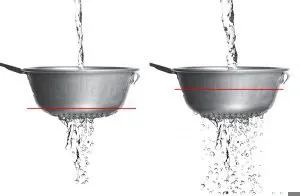TUTCO’s Wattage Calculator: How does it work?
TUTCO’s online Wattage Calculator on the TUTCO website, is a valuable tool in determining process heat solutions. It will provide a good approximation of the power required. The calculator app applies a chosen safety factor to calculate the necessary wattage needed.
Let’s explore the relationship between heat and temperature.
We all know that adding heat raises the application temperature, but while heat is being added to a system, heat is also lost due to a variety of factors. There is a balancing act of heat entering and leaving the system. Eventually the application stabilizes at a temperature that represents the balance of heat entering and leaving the system.

A fairly good analogy is that of water running through a colander.
If you were to hold the colander (the system) under running water (the heat source) some water will leak through the colander (the loss of heat to the environment), but after a few moments the water level inside the colander would stabilize at a constant level. That’s the heat balance in the system and corresponds to a certain temperature. If the water level were lower it means the system would be cooler.
Imagine you can change the size and spacing of the holes in the colander. This would represent the different materials you could potentially be heating, like Steel, Aluminum, Copper or any other material.
Continue to think of the temperature of the system as the level of water you’re able to maintain in the colander. The more water you run into the colander the more wattage (or power) you’re putting into the system. As the water enters the colander, it leaks out. It leaks more as you run water faster into the system because the water in the colander rises, exposing itself to more holes to leak through. Eventually you reach a condition where the water level remains constant (as water is being poured into the colander) and the water leaking from the colander remains at a constant flow as well. When the water level remains constant, the water entering the colander equals the water leaving the colander. That constant water level is equivalent to the constant temperature that the system has achieved.
With similar colanders (or similar systems to be heated) different flow rates cause different amounts of water loss (heat loss) and different stable water levels (final temperatures).
If you were to repeat the process with a different system material, you would mimic that by altering the geometry of the colander you’re using. Maybe the holes would be smaller and farther apart. That type of colander would behave differently than the first and the system could get to a constant water level faster, and also attain a different water level. This analogy demonstrates that altering the system material (the colander geometry) will cause the system to level off at a different temperature in a different amount of time.
TUTCO’s Wattage Calculator considers several material properties used in your system to determine the input power required for your system to reach a specific temperature in a certain amount of time.

The third type of heat loss is conduction in which heat is lost through objects that are touching the system to be heated. Conduction losses cannot be accurately calculated with a simple tool like our wattage calculator because the geometries of things that could be touching the system to be heated are numerous. Is the system sitting on a large aluminum plate? Is the system held in the air with thin supports? Is the system part of a much bigger machine where it is completely encompassed by large pieces of steel? With this wide variety of options heat loss can’t be modelled with a simple tool. For the time being, conduction losses are ignored and can be accounted for by adding a 20% or 30% safety factor to the final wattage number.
Begin using the tool by entering the dimension of what’s being heated being sure to get the orientation of your object correct. The tool allows you to describe a rectangular solid with length, width and height (or thickness) numbers. If you need to represent a cylinder, approximate it with the closest rectangular solid you can use. The orientation of the object is important because an object in a vertical orientation will lose heat a little differently than the same object in a horizontal orientation.
Once you are satisfied with the object dimensions, select the material you’ll be heating. The drop-down list contains a large variety of materials to choose from. Once selected, the appropriate material properties will populate the specification box at the bottom left of the calculator.
Next, you’ll enter the starting temperature and final temperature you want to achieve, and the amount of time you want to reach that final temperature in. All these numbers can have a big effect on the wattage required to heat the system. Remember to enter your time number in hours, for example 30 minutes = 0.5 hrs, 15 minutes = 0.25 hrs and 5 minutes = 0.083 hrs, etc.
A final wattage number will be shown on the right side of the tool. You can adjust the numbers in the calculator and see how the wattage requirement changes.

A safety factor is provided for a couple of reasons. Any wattage calculator approximates the real world, and since there are always inaccuracies in any calculator, you want to add a little extra to make sure you’ve accounted for those inaccuracies. 20% is a good number to start with. This will ensure you have enough wattage for your application. Because this tool doesn’t take conduction into account, it’s best to set the safety factor to about 30%.
The TUTCO Wattage Calculator is an ideal tool for beginning the process of identifying the heating and temperature needs of your application. The results will give you a better understanding of your process and the wattage required to make it work. With this information in hand, TUTCO can provide you with the ideal heating solution.

